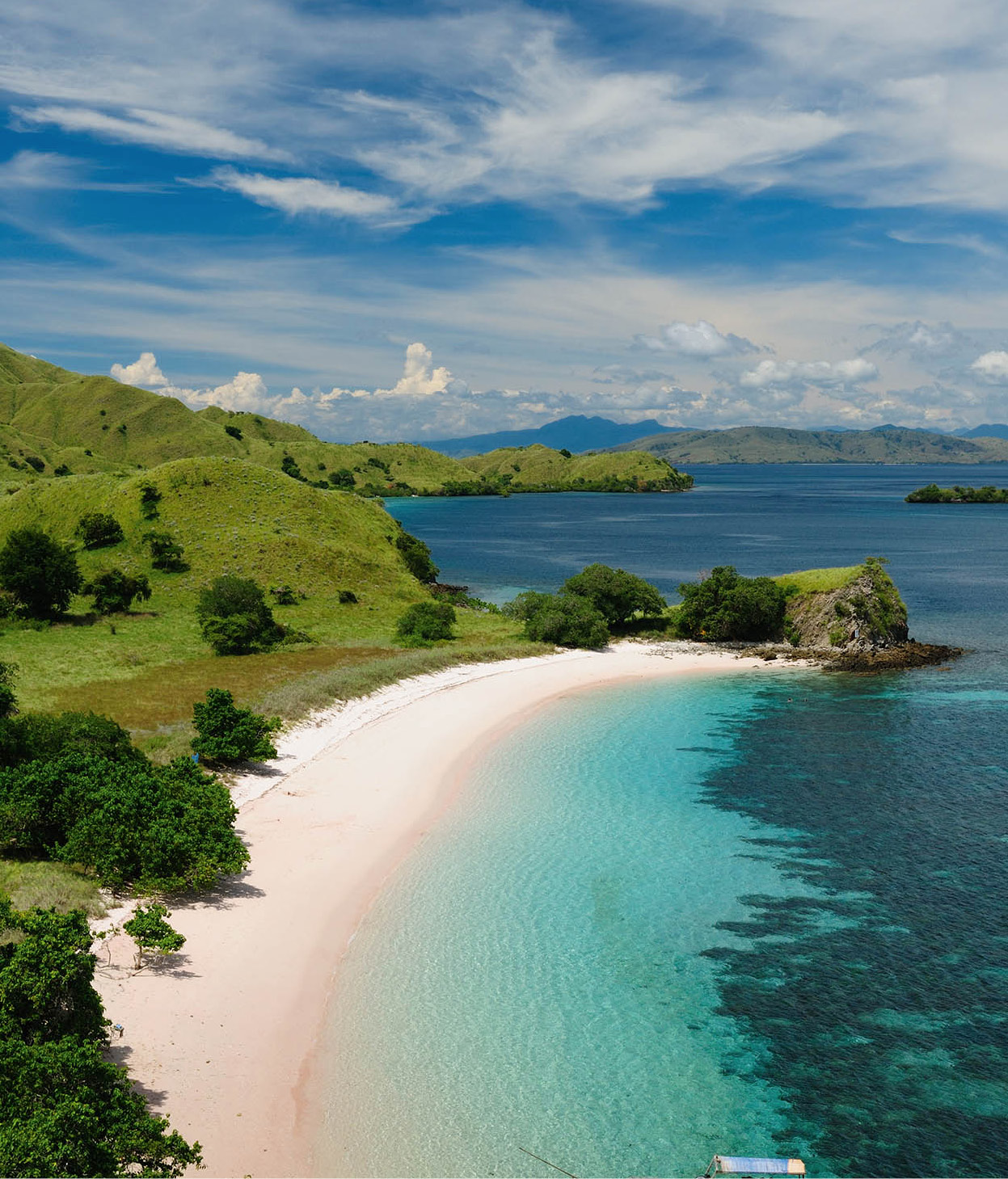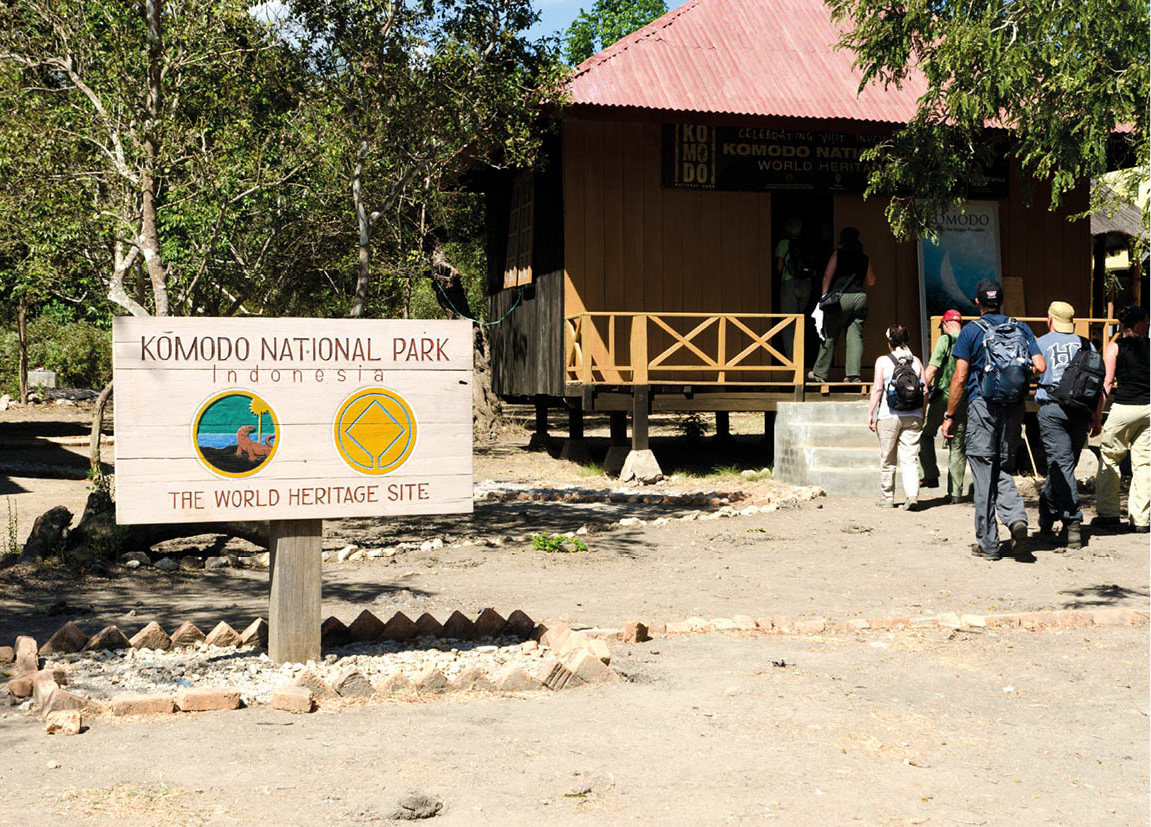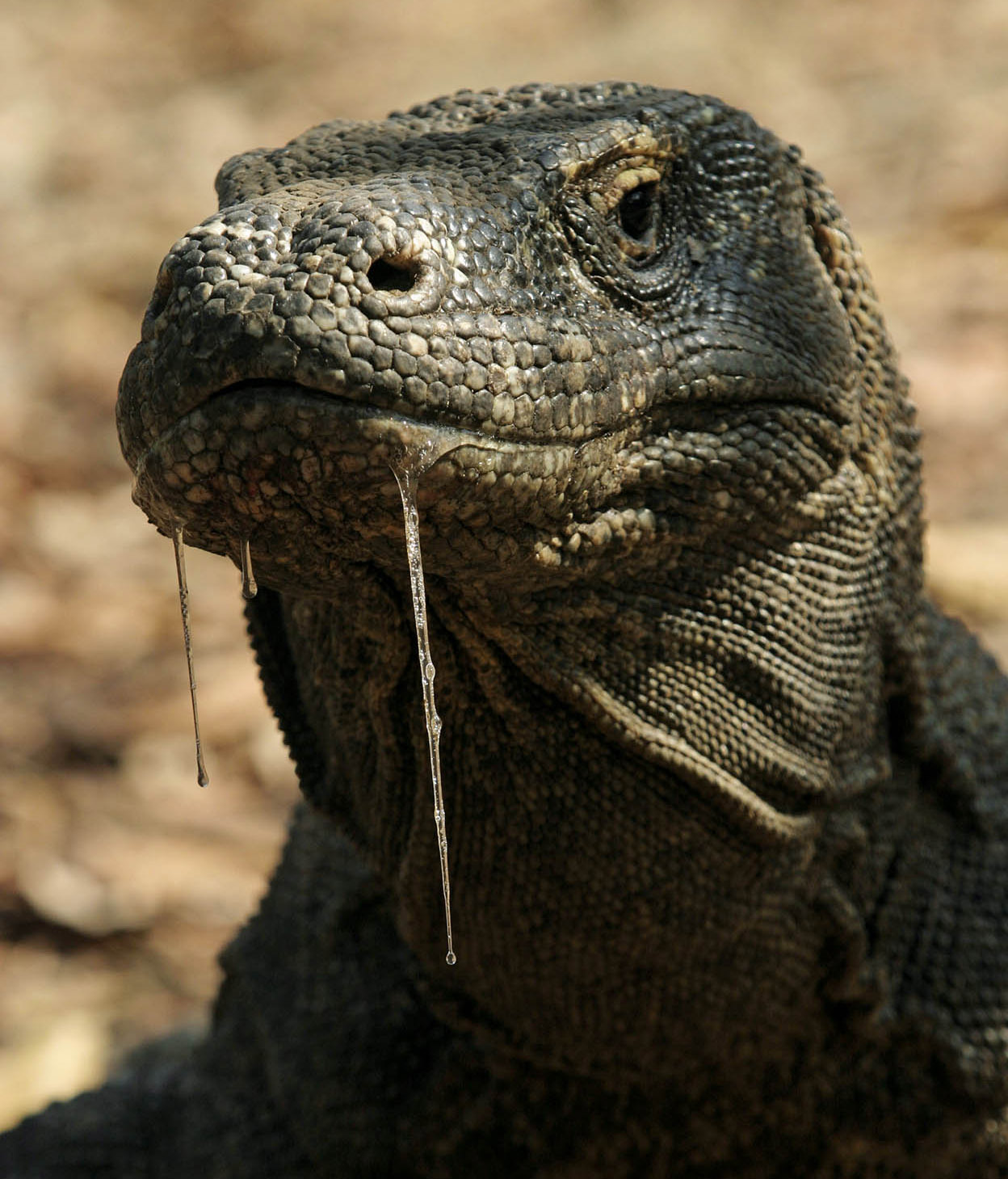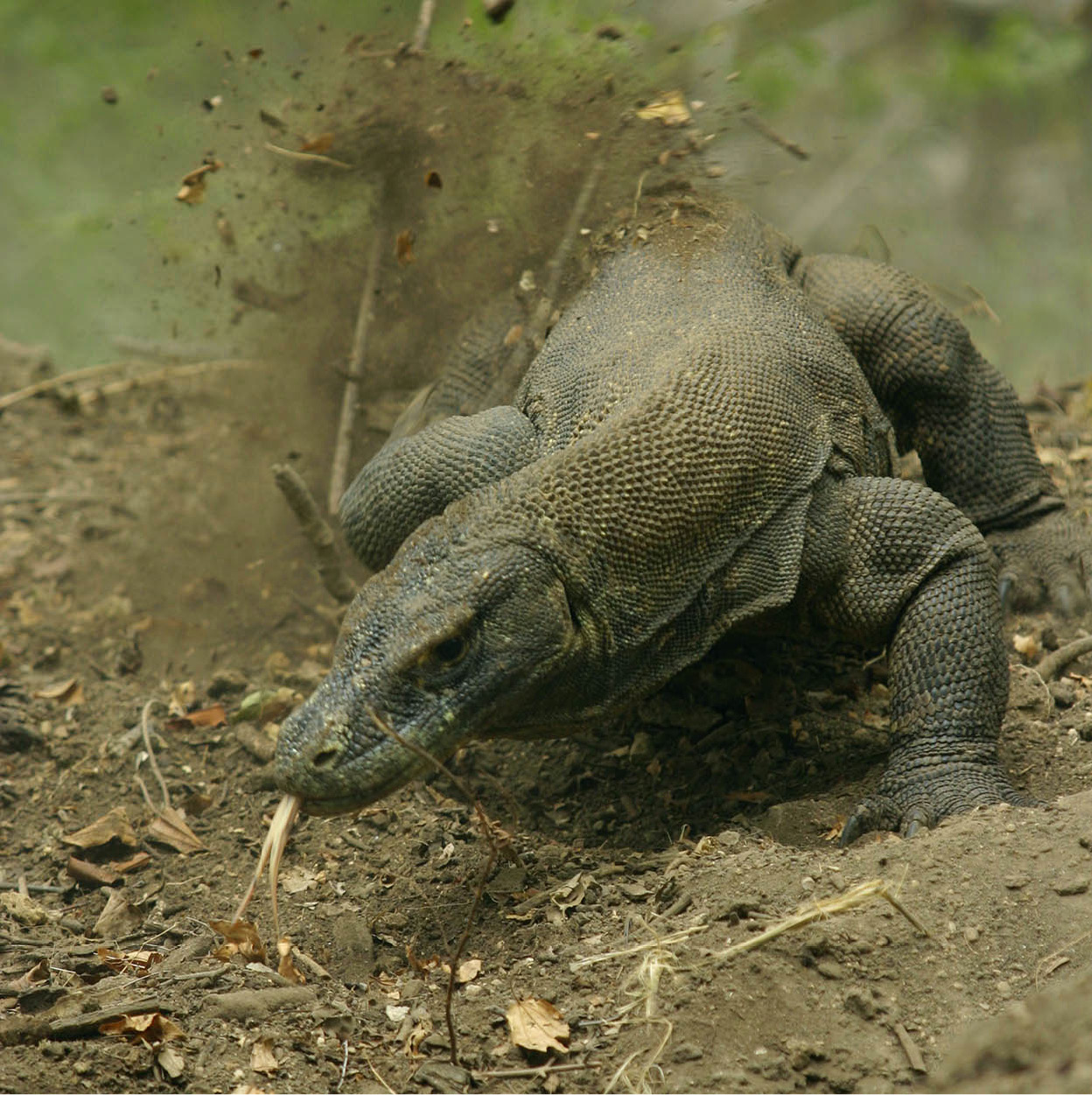A Unesco Man and Biosphere Reserve, and a World Heritage Site, Komodo National Park lies in the strait between Sumbawa and Flores and is the habitat of the world’s largest reptile, Varanus komodoensis, the Komodo dragon. This giant monitor lizard is one of the world’s oldest species, a close relative of the dinosaurs that roamed the earth 100 million years ago.
Although there are dragons on two other nearby islands, in order to protect wild populations visitors are only allowed on Komodo and Rinca (pronounced ren-cha).
Most visitors couple Komodo dragon-spotting with snorkelling and diving while in the park. During low tide at Pantai Merah (Red Beach), near Komodo, reefs teeming with colourful fish are very near the shoreline. Divers will appreciate the slopes, boulders and small rocky outcroppings nearby. The strong currents here provide plenty of plankton for small fish to feed on, in turn attracting larger ones, and provide migratory paths for whales and dolphins. Sea turtles are frequently seen here, too. Divers who venture further from the coast should be aware that extreme undertows have claimed lives.
Komodo island is home to several human settlements, including its largest village, Kampung Komodo (population about 1,300), located only a few kilometres west of Loh Liang ranger station. Villagers make a living primarily from fishing. They speak their own language and although predominately Muslim, also adhere to strong traditional beliefs. Modestly dressed visitors are welcome, particularly if they are interested in buying one of the locally carved Komodo dragon statues, seed pearls or souvenirs from elsewhere in West Nusa Tenggara.

Komodo island.
Fotolia

The visitor centre at Komodo National Park.
iStock
Visiting Komodo National Park
The highlight of a visit to the national park is seeing the dragons in their natural habitat. On Komodo 9 [map], the most popular trek is a 2km (1.2 mile) walk to Banunggulung. With prior arrangement, those who wish to see more of the elusive reptiles away from the tourist crowds can continue past Banunggulung to Poreng, in the northeastern part of the island, or as far as Sebita on the coast. Shorter walks are also possible from the ranger station at Loh Liang (where basic tourist accommodation is sited) to Kampung Komodo to the southwest. Trekkers on both islands must be accompanied by a park ranger, whose expertise at animal behaviour, as well as knowing where to look for and spotting wildlife, is invaluable. In addition to being responsible for your safety, the rangers will also point out other interesting flora and fauna en route. Although it is tempting to focus on photographing the beasts encountered, be constantly aware of everything else around you, including poisonous snakes. Keep your distance from all wild animals, and remember that the dragons can move very quickly if disturbed, that they are dangerous creatures and that medical attention is far away.

The saliva produced by Komodo dragons is highly septic.
Indonesian Tourist Board
The dragons of Komodo and Rinca
The dragons of Flores and Rinca display genetic similarities, whereas on Komodo and Gili Montang there is a clear pattern of genetic divergence. According to the International Union for Conservation of Nature’s list of threatened species, the Komodo dragon is not endangered, but is considered vulnerable. There are about 6,000 Komodo dragons on Komodo, Rinca, Gili Montang, Flores and Nusa Kode. The greatest threat to the monitors is from deer poachers, who kill off the animals on which they feed.
Male dragons can reach 3 metres (10ft) or more in length and weigh an average of 70kg (154lbs). Females usually attain only two-thirds of this size and lay up to 30 eggs at a time.
The reptiles are carnivores, favouring rotting meat, which they track by flicking their forked tongues into the air to identify odours. However, they can hunt when there is no carrion available; by lifting their massive bodies up on muscular legs they can sprint briefly at 20kph (12mph). Stealth predators, they lie in wait to ambush using claws and tails to knock victims senseless. If the lizard manages to sink its serrated teeth into the victim’s flesh, the creature will usually die from septicaemia due to the toxic bacteria in the dragon’s saliva.
During the mating season (July to August) Komodo dragons prefer to attend to the business at hand in seclusion, making them more difficult to spot.
There are several other trails to choose from, and park regulations require that all visitors be accompanied by a ranger (whose fee is nominal). The most frequented long-haul trek is to Gunung Ara (730 metres/2,390ft), one of a chain of mountains that extends along the northern part of Komodo. It is a one- or two-day excursion, and from the summit you can take in great panoramas of the islands, their craggy peaks, sandy bays and the sparkling turquoise sea. Similar views can be enjoyed from Gunung Satalibo, at 740 metres (2,420ft) high, the island’s tallest peak. The trails are those used by foraging animals, bordered by tall grasses concealing large stones, so sturdy walking shoes and trousers are recommended.
Scuba diving and snorkelling in the park waters are reputed to be some of the best in the Asia Pacific region. The 260 species of reef-building corals, sheer-drop walls and around 1,000 species of fish and marine mammals, including manta rays, sharks, sea turtles, dolphins and whales, are paradise to snorkellers and divers. With the marine area constituting 67 percent of the park, diving brings a significant number of tourists. The waters to the south of the park are cooler than those to the north, creating an ideal habitat for corals and reef fish, while to the north, rich plankton and nutrients attract a wide variety of temperate marine life. For snorkellers, Pantai Merah (Red Beach) offers butterfly, parrot and triggerfish, giant clams and colourful corals at close range. The gorgeous beach is pink due to an abundance of red coral in the region.
As Komodo National Park is in the transition zone described by 19th-century naturalist Sir Alfred Russel Wallace (for more information, click here), birdwatchers will find a mixture of Asian and Australian species. Squawking cockatoos and noisy friarbirds flock in tropical kapok and gnarled tamarind trees, disturbing green Imperial pigeons, black-naped orioles, sunbirds and flowerpeckers. On the forest floor there are jungle fowl, the forebears of domesticated chickens, quails scratching for insects and mound-building megapodes.

A reminder of the age of the dinosaurs.
Indonesian Tourist Board
Rinca
Not having received the same publicity as Komodo, Rinca ) [map] island is not as crowded as its more famous neighbour in the high season (July and August), and provides a far more natural experience.
On Rinca, there are two moderately easy treks (2–3 hours each) from the ranger station at Loh Buaya, which also has limited basic accommodation. One, to the east of the compound, is up and across a ridge where there is a breathtaking view of the Komodo group of islands, with Flores rising from the sea at one point. Watch for herds of wild horses, which are absent from Komodo. The other trail goes in the opposite direction through monsoon forest, where wild buffaloes wallow in streams.
Tip
When visiting Komodo, whether arriving by government ferry or by a private boat chartered on Sumbawa or Flores, be aware that the currents around Komodo are very strong and the seas usually rough. When swimming, keep an eye out for sea snakes, which are plentiful in these waters, and always be mindful of currents and riptides.
There is a shortage of park rangers on both islands in July and August, the busiest tourist season. Those wishing for longer treks requiring a ranger may be happier visiting during the off-season. It is best to leave on expeditions early in the mornings so you can see the animals at their most active, and you can avoid the extreme midday heat.